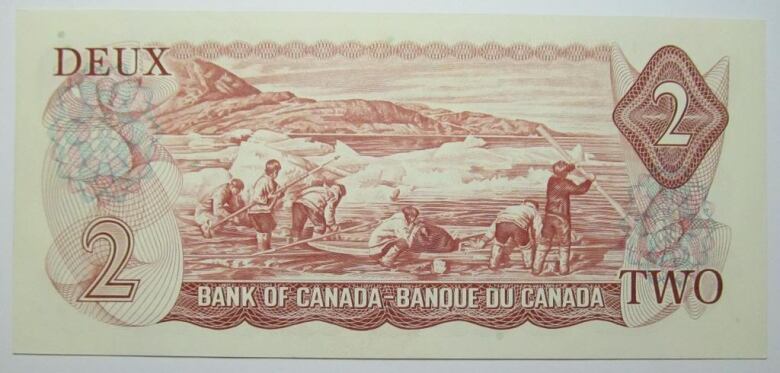'Human Flagpoles': Dark story behind Inuit scene on $2 bill
Musician Lucie Idlout says the discontinued bank note reflects a dark time for Canada's Inuit

If youre a Canadian of a certain age, youve likely seen the Idlout family. In fact, youve probably carried them around in your back pocket.
The reason: theyre featured on the back of the 1974 two-dollar bill.
Part of the Scenes of Canadaseries, the discontinued bank note depicts a group of six Inuit men preparing their kayaks for a hunt.

My grandfather was known to be an excellent hunter, said Idlout.
He was one of the first few Inuit to receive the Coronation medal from the Queen - I kind of view him as a superhero, even though I never met him.
Based on a photograph taken by documentarian Douglas Wilkinson, the bill features Joseph Idlout and his relatives hunting nearby the Baffin Island community of Pond Inlet.
On its surface, the bill appears to reflect nothing more than an innocent scene of daily Inuit life. But dig a little deeper, and the story behind the photograph becomes much more complicated.
We were basically human flagpoles.
In the 1950s, the Canadian government relocated a number of struggling Inuit families from Inukjuak (Quebec) to the communities of Resolute Bay and Grise Fiord - hundreds of kilometres to the north.
Ostensibly done to improve their standard of living, the realities of life in the High Arctic proved difficult for families accustomed to the warmer temperatures and more fertile tundra of Quebec. To ease their transition, Joseph Idlout was hired to instruct the southern Inuit on life in the unforgiving northern climate.
His role in Resolute Bay was to assist with teaching Inuit how to survive in a much harsher climate than what they were used to, said Idlout.
As the transplanted Inuit struggled to adapt to their new surroundings, the motivation behind their relocation became increasingly clear.

In 2010, the Minister of Indian Affairs and Northern Development issued an apology to Canadas Inuit people, expressing regret for the hardship and suffering caused by the relocation.
And while adjusting to a new and unfamiliar landscape was challenging, Lucie Idlout saidthat it was the actually the change in lifestyle that had the biggest consequences - both for the transplanted communities and for her grandfather.
With the amenities and modernness of southern life coming to the north it really changed the way Inuit lived," said Idlout.
It was a lot of change that happened really quickly, and it had a lot of negative impacts on the people who lived there.
And though he was considered to be an exceptionally skilled and well-respected man, the move proved to be particularly traumatizing for Joseph Idlout. Although reports of his death vary, Lucie Idlout says that her grandfathers eventual suicide can be traced back to the relocation.
The transition of life was just too fast and too much.
Bills were meant to inspire Canadian pride
The Scenes of Canada series, which was printed and put into circulation between 1969 and 1979, was meant to instill pride and reflect Canadian settlements from sea to sea.

I dont think theres any coincidence the photograph was shot in the 50s, just before the relocation, said Idlout. It is another example of how Inuit were part of asserting sovereignty over different parts so Canada could claim it as their own.
But despite the darkness the bill represents, Idlout still feels a certain pride when she looks at the image of her family on the $2 note.
It became less of a photo and more of a piece of our history - that involved important people from my family and people I love very much.
To hear the Lucie's full interview, tune in to the May 6th episode of Your DNTO-2:00pmon CBC Radio One.
With files from DNTO












_(720p).jpg)


 OFFICIAL HD MUSIC VIDEO.jpg)
.jpg)



























































































